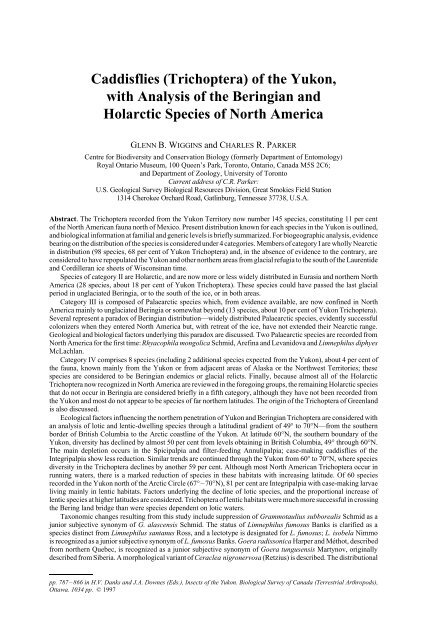Caddisflies of the Yukon - Department of Biological Sciences ...
Caddisflies of the Yukon - Department of Biological Sciences ...
Caddisflies of the Yukon - Department of Biological Sciences ...
Create successful ePaper yourself
Turn your PDF publications into a flip-book with our unique Google optimized e-Paper software.
<strong>Caddisflies</strong> (Trichoptera) <strong>of</strong> <strong>the</strong> <strong>Yukon</strong>,<br />
with Analysis <strong>of</strong> <strong>the</strong> Beringian and<br />
Holarctic Species <strong>of</strong> North America<br />
GLENN B. WIGGINS and CHARLES R. PARKER<br />
Centre for Biodiversity and Conservation Biology (formerly <strong>Department</strong> <strong>of</strong> Entomology)<br />
Royal Ontario Museum, 100 Queen’s Park, Toronto, Ontario, Canada M5S 2C6;<br />
and <strong>Department</strong> <strong>of</strong> Zoology, University <strong>of</strong> Toronto<br />
Current address <strong>of</strong> C.R. Parker:<br />
U.S. Geological Survey <strong>Biological</strong> Resources Division, Great Smokies Field Station<br />
1314 Cherokee Orchard Road, Gatlinburg, Tennessee 37738, U.S.A.<br />
Abstract. The Trichoptera recorded from <strong>the</strong> <strong>Yukon</strong> Territory now number 145 species, constituting 11 per cent<br />
<strong>of</strong> <strong>the</strong> North American fauna north <strong>of</strong> Mexico. Present distribution known for each species in <strong>the</strong> <strong>Yukon</strong> is outlined,<br />
and biological information at familial and generic levels is briefly summarized. For biogeographic analysis, evidence<br />
bearing on <strong>the</strong> distribution <strong>of</strong> <strong>the</strong> species is considered under 4 categories. Members <strong>of</strong> category I are wholly Nearctic<br />
in distribution (98 species, 68 per cent <strong>of</strong> <strong>Yukon</strong> Trichoptera) and, in <strong>the</strong> absence <strong>of</strong> evidence to <strong>the</strong> contrary, are<br />
considered to have repopulated <strong>the</strong> <strong>Yukon</strong> and o<strong>the</strong>r nor<strong>the</strong>rn areas from glacial refugia to <strong>the</strong> south <strong>of</strong> <strong>the</strong> Laurentide<br />
and Cordilleran ice sheets <strong>of</strong> Wisconsinan time.<br />
Species <strong>of</strong> category II are Holarctic, and are now more or less widely distributed in Eurasia and nor<strong>the</strong>rn North<br />
America (28 species, about 18 per cent <strong>of</strong> <strong>Yukon</strong> Trichoptera). These species could have passed <strong>the</strong> last glacial<br />
period in unglaciated Beringia, or to <strong>the</strong> south <strong>of</strong> <strong>the</strong> ice, or in both areas.<br />
Category III is composed <strong>of</strong> Palaearctic species which, from evidence available, are now confined in North<br />
America mainly to unglaciated Beringia or somewhat beyond (13 species, about 10 per cent <strong>of</strong> <strong>Yukon</strong> Trichoptera).<br />
Several represent a paradox <strong>of</strong> Beringian distribution—widely distributed Palaearctic species, evidently successful<br />
colonizers when <strong>the</strong>y entered North America but, with retreat <strong>of</strong> <strong>the</strong> ice, have not extended <strong>the</strong>ir Nearctic range.<br />
Geological and biological factors underlying this paradox are discussed. Two Palaearctic species are recorded from<br />
North America for <strong>the</strong> first time: Rhyacophila mongolica Schmid, Arefina and Levanidova and Limnephilus diphyes<br />
McLachlan.<br />
Category IV comprises 8 species (including 2 additional species expected from <strong>the</strong> <strong>Yukon</strong>), about 4 per cent <strong>of</strong><br />
<strong>the</strong> fauna, known mainly from <strong>the</strong> <strong>Yukon</strong> or from adjacent areas <strong>of</strong> Alaska or <strong>the</strong> Northwest Territories; <strong>the</strong>se<br />
species are considered to be Beringian endemics or glacial relicts. Finally, because almost all <strong>of</strong> <strong>the</strong> Holarctic<br />
Trichoptera now recognized in North America are reviewed in <strong>the</strong> foregoing groups, <strong>the</strong> remaining Holarctic species<br />
that do not occur in Beringia are considered briefly in a fifth category, although <strong>the</strong>y have not been recorded from<br />
<strong>the</strong> <strong>Yukon</strong> and most do not appear to be species <strong>of</strong> far nor<strong>the</strong>rn latitudes. The origin <strong>of</strong> <strong>the</strong> Trichoptera <strong>of</strong> Greenland<br />
is also discussed.<br />
Ecological factors influencing <strong>the</strong> nor<strong>the</strong>rn penetration <strong>of</strong> <strong>Yukon</strong> and Beringian Trichoptera are considered with<br />
an analysis <strong>of</strong> lotic and lentic-dwelling species through a latitudinal gradient <strong>of</strong> 49° to 70°N—from <strong>the</strong> sou<strong>the</strong>rn<br />
border <strong>of</strong> British Columbia to <strong>the</strong> Arctic coastline <strong>of</strong> <strong>the</strong> <strong>Yukon</strong>. At latitude 60°N, <strong>the</strong> sou<strong>the</strong>rn boundary <strong>of</strong> <strong>the</strong><br />
<strong>Yukon</strong>, diversity has declined by almost 50 per cent from levels obtaining in British Columbia, 49° through 60°N.<br />
The main depletion occurs in <strong>the</strong> Spicipalpia and filter-feeding Annulipalpia; case-making caddisflies <strong>of</strong> <strong>the</strong><br />
Integripalpia show less reduction. Similar trends are continued through <strong>the</strong> <strong>Yukon</strong> from 60° to 70°N, where species<br />
diversity in <strong>the</strong> Trichoptera declines by ano<strong>the</strong>r 59 per cent. Although most North American Trichoptera occur in<br />
running waters, <strong>the</strong>re is a marked reduction <strong>of</strong> species in <strong>the</strong>se habitats with increasing latitude. Of 60 species<br />
recorded in <strong>the</strong> <strong>Yukon</strong> north <strong>of</strong> <strong>the</strong> Arctic Circle (67° – 70°N), 81 per cent are Integripalpia with case-making larvae<br />
living mainly in lentic habitats. Factors underlying <strong>the</strong> decline <strong>of</strong> lotic species, and <strong>the</strong> proportional increase <strong>of</strong><br />
lentic species at higher latitudes are considered. Trichoptera <strong>of</strong> lentic habitats were much more successful in crossing<br />
<strong>the</strong> Bering land bridge than were species dependent on lotic waters.<br />
Taxonomic changes resulting from this study include suppression <strong>of</strong> Grammotaulius subborealis Schmid as a<br />
junior subjective synonym <strong>of</strong> G. alascensis Schmid. The status <strong>of</strong> Limnephilus fumosus Banks is clarified as a<br />
species distinct from Limnephilus santanus Ross, and a lectotype is designated for L. fumosus; L. isobela Nimmo<br />
is recognized as a junior subjective synonym <strong>of</strong> L. fumosus Banks. Goera radissonica Harper and Méthot, described<br />
from nor<strong>the</strong>rn Quebec, is recognized as a junior subjective synonym <strong>of</strong> Goera tungusensis Martynov, originally<br />
described from Siberia. A morphological variant <strong>of</strong> Ceraclea nigronervosa (Retzius) is described. The distributional<br />
pp. 787 – 866 in H.V. Danks and J.A. Downes (Eds.), Insects <strong>of</strong> <strong>the</strong> <strong>Yukon</strong>. <strong>Biological</strong> Survey <strong>of</strong> Canada (Terrestrial Arthropods),<br />
Ottawa. 1034 pp. © 1997
















